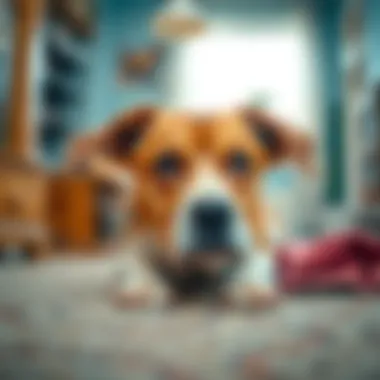Top Strategies for Removing Dog Urine Odor from Carpets


Intro
Dealing with a dog’s urine odor in your carpet can be quite a challenge. Anyone who has welcomed a furry friend into their home knows that, while they bring joy and companionship, they can also leave behind stubborn stains and unpleasent smells. The nice thing is that pet owners today have various tools and strategies at their disposal to tackle these issues. In this article, we’ll explore effective solutions for banishing dog urine odor from your carpets, diving into not just cleaning methods, but also practical tips that can help prevent future mishaps.
When we think about housebreaking a dog or managing established habits, many factors come into play. Understanding pet behaviors, utilizing the right cleaning products, and maintaining a consistent cleaning routine are just a few pieces of the puzzle that contribute to a fresher home. Here, we aim to empower you with comprehensive knowledge that can make a real difference in your living space.
Before we jump into solutions, it’s vital to understand that addressing the odor isn't a one-size-fits-all scenario. The cleaning methods and products you choose should align with the type of carpet you have, the severity of the odor, and the urgency of the situation. With some effort and the right strategies, you can create a home environment that is clean and welcoming for both you and your four-legged companions.
Let’s start with the core topic: eliminating dog urine odor from carpets.
Understanding Dog Urine Odor
Dog urine odor is a concern for many pet owners, particularly those living in settings with carpeting. The persistence of this odor can be quite frustrating and can affect the quality of life in any household. Grasping the nature of dog urine odor is critical, as this knowledge lays the foundation for effective cleaning strategies. There are several elements to take into account, including the chemistry of urine, why the scent is so stubborn, and what elements of carpet make it a suitable trap for these odors.
The Composition of Dog Urine
Dog urine is primarily composed of water, comprising about 95% of its content. The remaining 5% includes urea, creatinine, uric acid, and various other waste products. Urea is a significant component that breaks down into ammonia, which contributes to the strong smell that is identifiable even to human noses. Additionally, factors such as the dog’s diet, hydration levels, and health can affect the odor's intensity and composition. A diet rich in protein can produce stronger-scented urine, while a well-hydrated dog will typically produce less concentrated urine, reducing the odor.
Why Odor Persists in Carpets
Carpets are notorious for retaining odors, and dog urine is no exception. The fibers in carpets can trap liquid, allowing urine to seep deep into the underlay and padding. This is especially true for dense or plush carpets. Moreover, the uric acid in dog urine crystalizes after drying, making it even tougher to eliminate. These crystallized components can reactivate and release odors when they come in contact with moisture, such as humidity or cleaning solutions—leading to an ongoing cycle of odor issues.
To make matters worse, many cleaning methods simply mask the odor without addressing the root cause. Regular vacuuming or even shampooing may not penetrate deeply enough to tackle the source of the smell, resulting in frustration for pet owners eager to maintain a fresh atmosphere.
Impact of Urine on Carpet Fibers
When dog urine finds its way onto carpet fibers, it doesn’t just create an unpleasant smell; it also has the potential to damage the fibers. The proteins and salts in urine can weaken the integrity of the carpet over time and may cause discoloration, particularly in lighter shades of carpeting. This deterioration can lead to an aesthetically displeasing appearance that makes pet owners question whether they should replace their flooring altogether.
It's vital to address the problem promptly and properly to avoid long-term damage to the carpets. The sooner the urine can be treated, the better the chances of preserving both the appearance and longevity of the carpeting. Understanding these elements of dog urine odor is not merely about addressing a nuisance; it's about ensuring your home's environment remains healthy and inviting.
Identifying the Right Cleaning Products
When it comes to tackling the stubborn odor of dog urine in carpets, knowing how to nail down the right cleaning products is key. This decision isn't just about the urgency of the situation; it's about choosing effective solutions that can penetrate the fibers of your carpet and truly eliminate the odor at its core. A wide range of products exists on the market, from enzymatic cleaners to DIY solutions, each with unique merits and drawbacks. Making an informed choice can save you time, effort, and possibly money.
Commercial Odor Neutralizers
Commercial odor neutralizers have earned their place in households battling persistent pet odors. Their formulations are typically designed to break down the elements responsible for the smell, delivering a cleaner, fresher result.
Enzymatic Cleaners
Enzymatic cleaners have become quite popular for their specific capability. They contain enzymes that actively break down uric acid and other compounds found in dog urine. This characteristic makes them particularly beneficial since standard soaps or detergents may not effectively target these components. When applied correctly, enzymatic cleaners digest the odor-causing substances and neutralize the scent rather than just masking it. The downside? They might require more time to work, and some brands may leave a residue if not properly rinsed.
Oxygen-Based Treatments
Oxygen-based treatments, another formidable contender, operate on a somewhat different principle. This type of cleaner utilizes oxygenation to lift stains and odors away from carpet fibers. The key feature here is their ability to completely oxidize the components of the urine, which not only smells bad but can also negatively impact your carpets. Many people appreciate oxygen-based solutions because they often double as stain removers. However, care has to be taken with certain fabrics, as some treatments might discolor or damage delicate materials.
Pet-Safe Formulations
Pet-safe formulations are all about keeping your furry friends safe while fighting those nasty odors. These products typically steer clear of harsh chemicals, focusing instead on more natural ingredients that won’t harm pets or humans. It's a critical choice for homes with multiple animals or young kids darting about. Unique in their composition, these formulations are often biodegradable and eco-friendly. However, while pet-safe options are undoubtedly gentler, they may not always promise a powerful punch against stubborn odors compared to their more aggressive counterparts.
DIY Solutions
On the other end of the spectrum, DIY solutions can be a go-to method for many pet owners looking for budget-friendly alternatives or simply opting for natural ingredients.
Vinegar and Baking Soda


The combination of vinegar and baking soda stands out as an oldie but goodie in the world of carpet cleaning. Vinegar acts as a natural deodorizer, cutting through the odors with its acidic properties, while baking soda is a fabulous absorbent that can draw out moisture and smells. It's a straightforward and safe choice, which many find effective for smaller accidents. However, some people might find the vinegar scent itself off-putting, even as it dissipates after drying.
Hydrogen Peroxide Mixtures
Another DIY favorite is hydrogen peroxide, often mixed with water or dish soap. This cleaning agent has groundbreaking properties, breaking down urine stains and odors through its oxidative capabilities. Users favor it for not only its effectiveness on carpets but also its ability to sanitize the affected area. However, a word of caution is in order; some carpet fibers, particularly darker or dyed ones, can get bleached out if left unattended.
Essential Oil Blends
Lastly, essential oil blends can add a fragrant touch to the removal process. Utilizing oils such as lavender or tea tree oil, pet owners can concoct mixtures that not only fight odors but also leave a pleasant scent behind. These oils tend to have antibacterial properties as well, which is an added bonus. On the flip side, essential oils can be potent, so using them sparingly is a necessary caution, particularly around sensitive animals.
Ultimately, identifying the right cleaning products can make or break your battle against dog urine odor. Whether you choose commercial options or opt for DIY remedies, understanding the strengths and weaknesses of each solution is vital.
Evaluating Product Effectiveness
Evaluating the effectiveness of products designed to remove dog urine odor is crucial for pet owners striving to maintain a clean living environment. Understanding how various factors play into cleaning success empowers individuals to make informed choices. This section will outline the specific elements that influence the efficiency of remedies, helping you choose the best course of action to tackle persistent odors.
Factors Influencing Effectiveness
Type of Carpet Material
The type of carpet material significantly impacts how well a cleaning product performs. For instance, synthetic fibers such as nylon and polyester are generally resistant to stains and odors. Their tight weave can also prevent urine from soaking deeply, making cleanup somewhat easier. On the flip side, natural materials like wool may absorb odors more readily due to their porous nature. Wool can be a popular choice for its aesthetic and durability; however, it may trap odors longer when not cleaned promptly. Some benefits of synthetic fibers include:
- Stain resistance: Easier to clean; resistant to many spills.
- Durability: Typically last longer even with repeat cleanings.
- Cost-effective: Generally less expensive than natural fibers.
However, natural fibers like wool can present challenges, such as:
- Odor retention: Requires specialized cleaning to remove tough smells.
- Higher cost: Often more expensive initially and to maintain.
Duration of Stain
The duration of a stain relates to how long the urine has been allowed to settle into the carpet. Fresh stains are much easier to clean since the urine has not yet had a chance to dry and seep into the fibers. In contrast, older stains may become embedded in the carpet backing, complicating remediation efforts. A few points regarding duration include:
- Immediate action: Addressing the issue ASAP can drastically increase successful odor removal.
- Stubborn stains: Longer durations often mean that special treatments or professional cleaning may be necessary.
This timeline aspect matters greatly, as the chances of odorous particles bonding with the carpet increase the longer they remain unchecked.
Concentration of Urine
The concentration of urine can vary, depending on the dog’s hydration and health. A more concentrated urine sample, which can appear darker in color, will likely carry stronger odors and cause more significant staining. This concentration directly affects how well a product can neutralize the smell. Here’s why this is worth considering:
- Stronger reactions: Higher concentrations may require more robust products or techniques to be effective.
- Health implications: Consistent high concentrations might indicate underlying health issues with your pet, requiring a vet's consultation.
Understanding how concentration plays a role in both odor retention and removal can guide your choice of odor-fighting methods.
User Reviews and Testing
User reviews and real-world testing offer invaluable insights into product effectiveness. Potential buyers can delve into the experiences and outcomes reported by fellow pet owners. Having feedback from numerous users allows for a comprehensive overview of different cleaning products and their respective performance. It's often in these collective experiences that patterns emerge, helping to sift the wheat from the chaff when considering solutions for urine odor removal. Furthermore, when deciding on what cleaning product might work best, you could:
- Check forums like reddit.com, where pet owners share personal stories.
- Visit websites like consumerreports.org for professional evaluations.
In summary, evaluating product effectiveness encompasses various contributory factors, each playing a vital role in ensuring success in tackling dog urine odors. By keeping these elements in mind and looking into user experiences, you'll be well-equipped to make a sound choice for your carpet cleaning needs.
Practical Steps for Removal
When tackling the stubborn issue of dog urine odor in carpets, diving into actionable steps can make all the difference. This section outlines practical methods that pet owners can employ to effectively remove odors and ensure their living spaces smell fresh. A successful cleaning regimen not only addresses current odors but can also prevent further damage and lingering smells.


Initial Cleaning Process
Blotting Techniques
Blotting is essential when addressing a fresh stain. The main idea is to use a clean cloth to absorb as much liquid as possible before it seeps deeper into the carpet fibers. The key characteristic of this technique lies in its simplicity and speed. Using a cloth or paper towel, gently dab at the spot without rubbing it—this avoids pushing the urine further down.
A unique feature of blotting is that it works swiftly, which is critical in reducing odor. The sooner you tackle the stain, the less likely it is to set. One disadvantage of relying solely on blotting is that it might not completely eliminate the odor if the urine penetrated too deep. However, as an initial step, it is a popular and effective choice.
Using Water Effectively
Using water is another critical initial procedure. It helps to dilute the urine and further aids in lifting it out of the fibers. Pouring a small amount of lukewarm water onto the stain can create a solution that you can then blot up. The beauty of this method is that it's just water—no harsh chemicals involved.
One of the advantages is it's accessible and inexpensive. However, a unique aspect to keep in mind is that too much water can lead to additional problems, like mold or mildew developing in the carpet padding beneath. Thus, a well-measured application is crucial.
Applying the Chosen Product
Correct Application Methods
Applying the right cleaning product is another crucial step in this cleaning journey. It's vital to ensure that you follow the instructions provided by the product. Most products recommend applying it directly to the stain and allowing it to sit for the recommended time. The key characteristic of this approach is that it allows the cleaner to penetrate and break down the odor-causing elements of the urine.
This method stands out for its effectiveness in combating odors, but it's essential to test the product on a small, inconspicuous area of the carpet first. One disadvantage to be mindful of is that over-application can create residue, which can attract more dirt over time.
Timing and Duration
Timing and duration also play a critical role in odor removal. Most products recommend allowing the cleaner to sit for a specified period, often between 5 to 15 minutes. This step is essential because it gives the active ingredients time to do their job effectively. The key aspect here is patience—rushing this process can lead to incomplete cleaning and persistent odors.
The notable feature of focusing on timing is that it can profoundly affect the result of your cleaning efforts. However, if products are left on too long, they could damage the carpet fibers or lead to discoloration. Therefore, keeping an eye on the clock is an important part of the application process.
Final Steps to Ensure Odor Removal
Rinsing Techniques
Once the chosen product has been allowed to work its magic, rinsing is the essential step often overlooked. Rinsing techniques vary, but generally, this involves using clean water to remove any cleaning product residue from the carpet. This step is vital as leftover chemicals can cause their own odors or damage the fibers. The beauty of rinsing is that it helps to ensure that what you've used to clean doesn't create new problems.
However, it’s critical to avoid over-saturating the carpet during rinsing. This cautious approach is key to preventing water damage or the growth of mold in unseen areas.
Drying Process
After rinsing, drying the area thoroughly is paramount. Wet carpets can lead to not just odors, but mold growth as well. One of the more effective drying methods is to use fans, which improve airflow and speed up the process. Another option is simply to open windows to facilitate outdoor air exchange.
The distinctive feature of focusing on dry time is its contribution to a fresh, odor-free environment. On the downside, improper drying techniques, like using excessive heat, can damage carpet fibers or cause shrinkage.
Preventative Measures
When it comes to managing the challenge of dog urine odor in carpets, preventative measures play a crucial role. It’s far easier to prevent a problem than to solve it after it occurs. Pet ownership brings joy, but it also demands a level of responsibility regarding your living environment. This section highlights techniques that not only help avoid accidents but also set the stage for a cleaner, fresher home.
Training and Behavior Management
Training your dog is paramount in reducing accidents within the house. Establishing a consistent routine helps your canine understand expectations regarding where and when to relieve themselves. Here are a few strategies:
- Frequent Walks: Taking your dog out regularly can prevent indoor accidents. Puppies, in particular, have tiny bladders and need to be given multiple chances throughout the day.
- Positive Reinforcement: Use treats or praises to reward your dog when they go to the right spot outside. This method of training is not only effective but builds a bond with your pet.
- Crate Training: Dogs generally avoid soiling their sleeping area. A properly sized crate can give them a sense of security while also helping to control where they relieve themselves.
Implementing these measures can significantly reduce the likelihood of unsightly stains and odors, ensuring that every paw-tastic moment with your pet is free from the worry of mishaps.
Regular Maintenance Tips


Maintaining cleanliness can divert potential issues related to dog urine. Incorporating regular cleaning into your routine will set you ahead of the game.
Routine Cleaning Schedules
Establishing a routine cleaning schedule is not just a good idea; it’s essential for long-term results. This approach means allocating specific days for deep cleaning your carpets, which can help create a habit. Dogs are unpredictable creatures, and having a set plan can keep you prepared.
One key feature of routine cleaning is that it reduces stubborn odors from taking root. Skipping a scheduled cleaning can easily lead to accumulations of dirt and odor, making it harder to tackle later. Here are a few pointers:
- Frequency: Aim for at least bi-weekly vacuuming, along with monthly deep cleans using appropriate carpet cleaners.
- Consistency: Consistency is key; sticking to your schedule allows you to quickly address any mishaps before they become a lingering issue.
A routine cleaning schedule balances your time and keeps your home fresher, lowering stress during unpredictable puppy antics.
Carpet Protection Solutions
Investing in carpet protection solutions is often overlooked, yet it’s a wise step for any pet owner. These products help shield carpets from potential stains or odors caused by accidents.
One major characteristic is their ability to form a barrier. Many of these products spray or apply easily, creating a layer that repels liquids and dirt. The benefit? It can save you the trouble of deep cleaning if an accident occurs. Just read the instructions and ensure your chosen solution is pet-safe.
- Pros: These solutions prevent stains and extend the life of your carpets, making them a popular choice for pet owners. Plus, they often come in easy-to-apply forms.
- Cons: However, effectiveness can depend on maintenance. If not reapplied regularly, the protective barrier may diminish over time. Additionally, some products could alter the feel of your carpet; always test a small area first.
In summary, these preventative measures—training, routine cleaning, and protective solutions—provide a multi-faceted approach to keeping carpets fresh and odor-free. By being proactive, pet owners can enjoy their companions without the lingering worry of pet accidents.
Expert Insights
Understanding pet ownership challenges, especially the persistent issue of dog urine odor, requires more than just basic cleaning knowledge. Insights from industry professionals shed light on effective strategies and the science behind them. They reveal nuanced perspectives that often escape the everyday pet owner. This section emphasizes the necessity of drawing from the expertise of veterinarians, professional cleaners, and pet behavior specialists. Their insights not only enhance cleaning efficacy but also contribute to a deeper understanding of why odors linger and how best to tackle the problem.
Interviews with Pet Care Professionals
Engaging with specialists in pet care can be enlightening. For instance, a conversation with a local veterinarian might highlight that diet plays a crucial role in urine composition. Certain foods can elevate the pungency of urine, making it crucial for pet owners to be mindful of what they feed their dogs.
A professional carpet cleaner shared that many house cleaning products are inadequate for pet odors because they don’t contain enzymes specifically formulated to break down the uric acid in urine. This underscores the importance of using products designed for pet owners.
"The right cleaner can save you time, money, and heartache in the long run. Don’t skimp on the details; your nose will thank you."
— Carole, Carpet Cleaning Specialist
Furthermore, involving pet trainers in these discussions can provide useful behavior strategies. The insights they offer about seeking to mitigate accidents can be invaluable, helping pet owners to focus not just on cleaning but also on prevention.
Case Studies of Successful Odor Removal
Real-world examples provide powerful evidence of strategies that work. For instance, one homeowner had persistent urine odor despite regular cleaning. They decided to consult a professional cleaner after trying various household remedies, which led to a complete assessment of the carpet. The professional identified high-soil areas needing more attention and recommended a thorough steam cleaning using a specialized enzymatic product. This method not only eradiated the odor but also revitalized the carpet fibers, demonstrating how professional intervention can be a game changer.
Another case study involves a family adopting a rescue dog who had a history of accidents indoors. Instead of solely focusing on cleaning, they engaged a dog trainer to change their new pet's habits, while simultaneously using a homemade vinegar and baking soda solution when accidents occurred. The dual approach not only improved their dog’s behavior but also ensured their home remained odor-free.
These insights and examples delineate a path forward for pet owners who feel overwhelmed by the task of maintaining a fresh home. By prioritizing expert recommendations and learning from real-life situations, they can forge effective strategies in the ongoing battle against dog urine odor.
End and Recommendations
In wrapping up our exploration of how to tackle dog urine odors from carpets, it’s clear that addressing this issue is not just a matter of immediate cleanliness—it delves into creating a comfortable living environment for both humans and pets. The essence of this discussion lies in understanding the underlying factors that contribute to persistent odors and the myriad of solutions available to combat them.
Summarizing Key Points
To recapitulate, let’s take a closer look at the significant aspects we’ve uncovered:
- Composition of Dog Urine: Recognizing the complex biochemical nature of urine is crucial to understanding why odors linger. The combination of urea, ammonia, and various salts means traditional cleaning methods might not always suffice.
- Cleaning Options: From commercial products to DIY methods, there’s a spectrum of effective solutions available. Enzymatic cleaners break down odor-causing compounds, while natural remedies like vinegar and baking soda offer affordable alternatives.
- Evaluation of Effectiveness: Factors such as carpet type, stain age, and urine concentration significantly influence the success of any cleaning attempt. Knowing these can lead to more informed choices.
- Practical Cleaning Steps: Implementing systematic cleaning processes—not merely scrubbing but employing proper blotting and application methods—ensures thoroughness that pays off in the long run.
- Prevention Strategies: Keeping odors at bay requires ongoing maintenance and management strategies. Training pets and regular cleaning routines can curtail future mishaps effectively.
- Expert Insights: Learning from professionals' experiences enhances our understanding of best practices in odor removal, allowing pet owners to feel confident in their approaches.
Final Tips for Pet Owners
As a final word, here are some valuable reminders for all pet owners navigating this challenge:
- Immediate Action: Don’t let urine linger. The faster you address the stain, the simpler it becomes to manage the odor.
- Use the Right Tools: Invest in a quality enzymatic cleaner. It’s often an upfront cost, but it pays off when it terms of effectiveness and time saved.
- Check Carpet Labels: Understand the materials used in your carpets. Knowing this can guide you toward the right cleaning solutions and methods.
- Stay Consistent: Regularity matters. Establish a cleaning schedule that includes carpet care, going beyond just tackling stains as they occur.
- Observe Your Pet: If certain areas become recurring hotspots for accidents, it may be indicative of underlying issues. Consult with a vet if behavior patterns seem problematic.
Knowledge is a powerful tool: By being proactive and informed, pet owners can significantly mitigate the prevalence of unpleasant odors, paving the way for a harmonious living space.
With these insights and strategies in mind, pet owners can actively combat dog urine odors, ensuring a fresh and enjoyable home for both pets and their humans.















